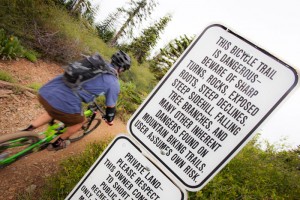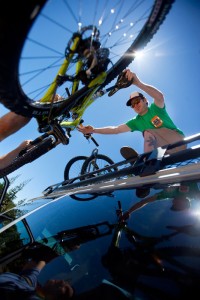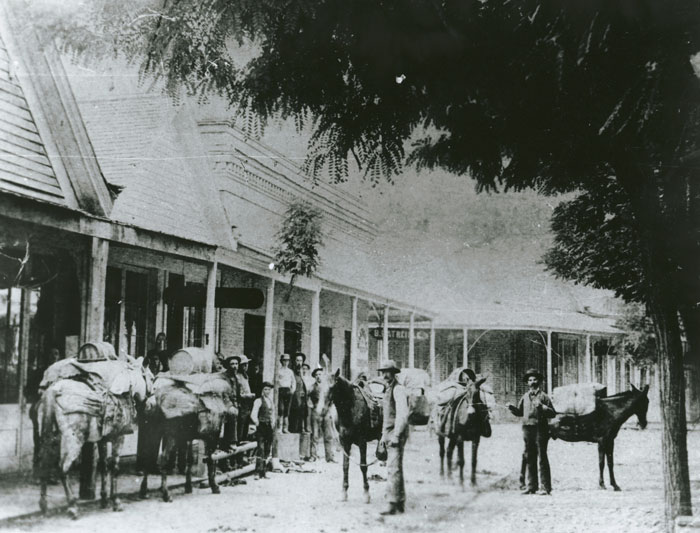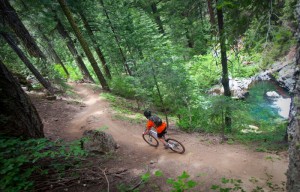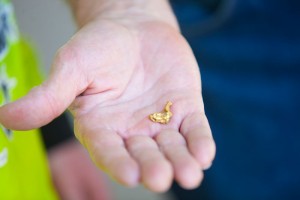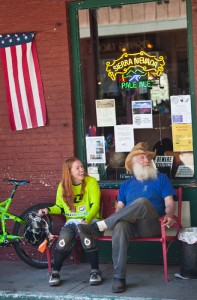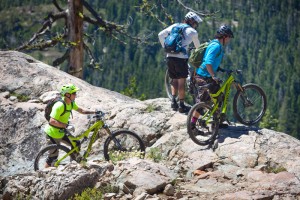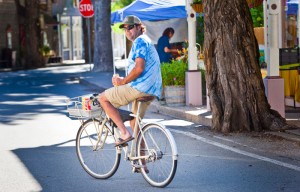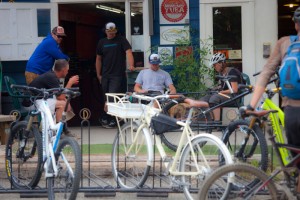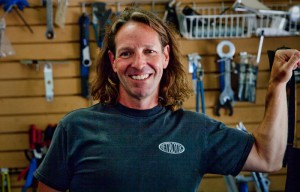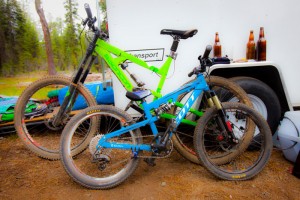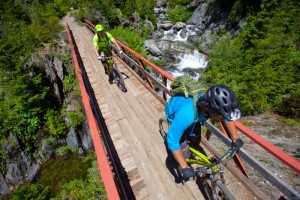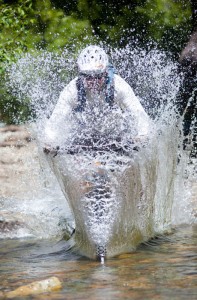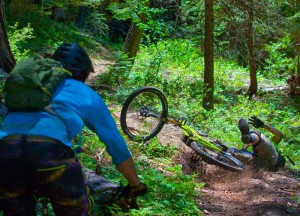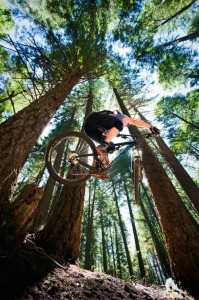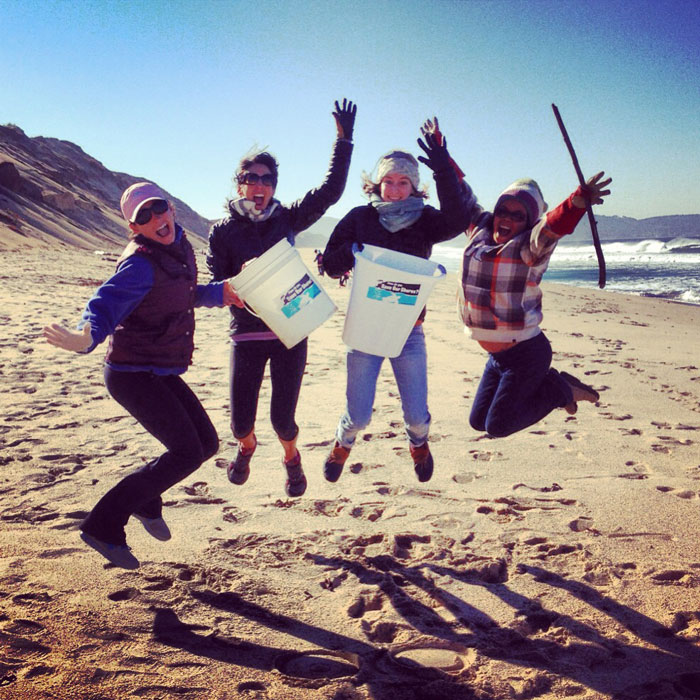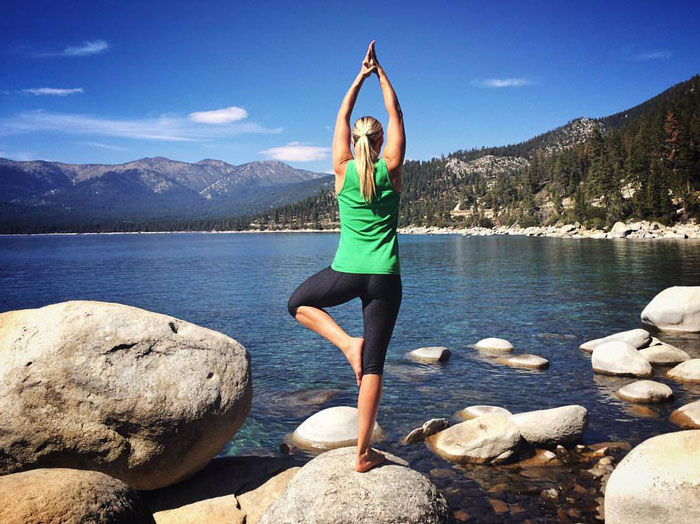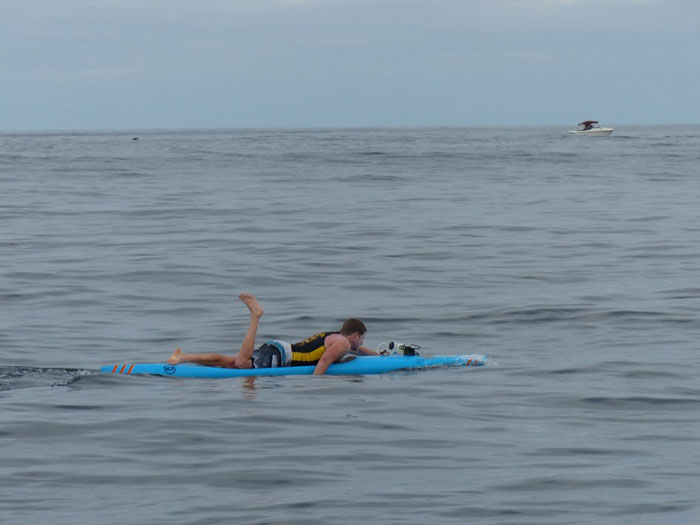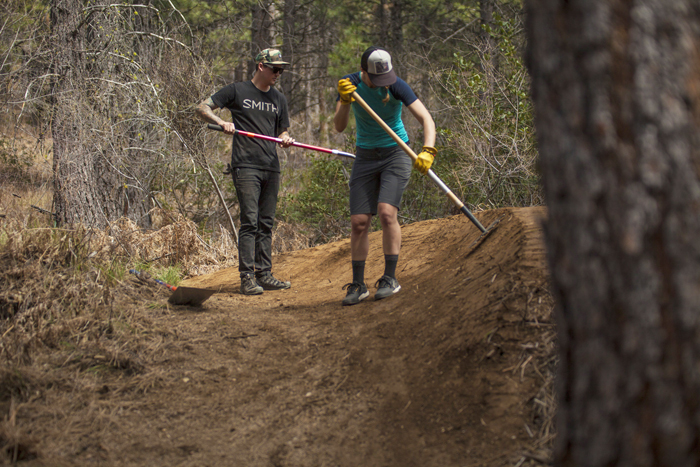- Tahoe’s Nevada Beach Tops the List of Hard-to-Book Campgrounds - 07/17/2024
- Cannabis Watershed Protection Program Cleans Up Illegal Grow Sites - 07/10/2024
- French Fire - 07/05/2024
A short history of MTB gold
Words & photos by Rick Gunn
I had returned to mountain biking’s mother lode.
Staring out the window of a shuttle van as it groaned toward Packsaddle Pass, I looked past a sweep of pines to a tiny box of metal perched atop the hulking granite peaks: the Sierra Buttes fire lookout.
Just to the west waited 14 miles of legendary singletrack—Downieville’s famous downhill. It had been a decade-and-a-half since my first ride here.
Less a mountain bike ride than a reenactment of the opening scene from the movie Saving Private Ryan, the recollection of that first ride conjures a kind of two-wheeled PTSD. For nearly three hours I battled rocks, and exploded through creeks, only to be catapulted into a series of spectacular endos. Picking myself up off the dirt time and again, I wobbled off the trail with a broken spoke, a bent crank, two broken toes, and a perverse yearning to do it all again.
Welcome to Downieville.
Now, more than a decade later, and perhaps a dozen descents under my belt, I returned to Downieville to explore its mountain-biking history, talk to some locals, and figure out how it all began.
I was in good company.
Sitting next to me in the shuttle van was Greg Williams, founder of Yuba Expeditions and executive director of the Sierra Buttes Trail Stewardship. Part Miwok Indian, Williams’ ancestors began cutting trails in this area during a time when the only full suspension rides included ears and a tail.
THE HISTORY
“Many of these trails existed before recreation was even a concept,” he said. “Some of them are pre-historic. My great, great, great, great, great, great grandfather, and my uncles built trails and guided miners out here during the Gold Rush of 1849.”
It was a time, he reminded me, “when everything around here went bat-shit crazy.”
Williams was referring to the 300,000 people that poured into the region from around the globe, all of them buzzed as hell on the idea of striking it rich in California’s gold fields. Included in this group was a simple Scottish prospector by the name of William Downie.
Downie had sailed all the way from Glasgow to San Francisco in the summer 1849, then boarded a schooner that took 11 days to reach Sacramento. Making his way by foot and mule train into Marysville, then onto the mining camps at Bullard’s Bar, he led a party of 10 on an expedition into a dense patch of wilderness along the north fork of the Yuba River.
In his book Hunting for Gold, Downie reflects upon his thoughts and aspirations:
“I little dreamed that the quiet of the mountains and the silence of the valleys were even at that hour echoing with the thunder of human emotions; that nature in its holiest solitude was being made the theater, in which was enacted the most powerful scenes of human aspirations, degradation and often vice in its most hideous form.”
Enduring drunks, thieves, claim jumpers – even grizzlies – Downie and his party eventually landed themselves in a place known as “Forks.” He wrote:
“As we rounded the point we beheld the Forks, the place of which we were in search and which afterwards received the name of Downieville. The scene that burst upon us was one of marvelous beauty, and after these many years it still lies before me like a lovely panorama. The silence of the woods was broken only by the rushing of the meeting currents below and the sighing of the breeze through the foliage. The sun was in the western sky, causing a variation of light and shadow to fall upon the landscape, which was exceedingly pleasing. The hillsides were covered with oaks, bending their crooked branches in phantastic forms, while here and there a mighty pine towered above them, and tall willows waved their slender branches, as it were, nodding us welcome.”
As glorious as that sounds, Downie’s time here got off to a rough start. Winter crept in, gold prospects dimmed, and his meager supplies ran alarmingly low. Then, one day a member of Downie’s party – Jim Crow – was frying up a 14-pound trout, only to discover gold lining the bottom of the kettle.
This marked the beginning of Downieville’s gold boom. From that point forward rivers in
and around Downieville began to produce bling.
Big bling.
In The California Gold Country, Elliott M. Koeppel wrote:
“One claim, yielded… $12,000 in eleven days, $80,000 in six months. The three partners at Tin Cup Diggins…wouldn’t quit work for the day until a tin cup had been filled with gold, which they had no trouble doing. A twenty-five-pound nugget of solid gold was found in the river two miles upstream from camp. With finds like this it’s no wonder that by May of 1850 an estimated two thousand miners were camped out at The Forks.”
By the mid-1850s, Downieville was California’s fifth-largest town. In 1852 it narrowly lost the bid to be the state capitol to Sacramento by ten votes. But as time passed, things changed.
Mining became mechanized, and Downieville’s gold was subsequently sucked dry. Over the next 160 years, Downieville’s population went from an estimated 5,000 in 1853 to about 300 in 2013.
THE REBIRTH
Today, Downieville is looking to a different kind of gold rush.
“The thing about Downieville and Western Sierra County,” Williams explained, “is that it went from one of the richest counties in the nation to one of the poorest. We don’t have a working landscape here anymore. We had mining, and then logging, and that’s gone now. Recreation is our next step.”
Although hunting, fishing, and camping were always recreational staples, when it came to mountain biking, the first leap forward came with the explosion of dirt bike riders in the 1970’s. That’s when the Forest Service began using green sticker motorcycle registration funds to improve Downieville’s trails. It was through that process that the idea of recreational trail building and maintenance began to take hold.
The 70’s were also when Williams first visited Downieville from his home in Nevada City. Arriving as a young boy on vacation with his father, his first adventures on Downieville’s single track took place on foot, then dirt bike, and then eventually on a rigid frame mountain bike.
“The first time I rode a mountain bike here was in the summer of 1988,” Williams said. “I rode down Butcher Ranch, and Third Divide Trail. First Divide didn’t even exist – or it did as old mining flumes, but there were a lot of pieces of it missing, and parts of it had to be blasted out. It was totally different back then; there were no downhill bikes – it was fucking survival out there.”
“I remember thinking to myself, ‘I’m gonna try and make it down the hill without blowing my shit up.’ Then one day, I rode from town to the top of Packer’s Saddle, and realized people would pay to have this experience.”
And from there, a shuttle service was born.
Williams joined two partners and started an outfit called the Coyote Adventure Company. With that he began hauling people for a long day trip from Nevada City to the top of the Sierra Buttes. After shuttling them to the top, he’d guide them down two runs, only to shuttle them back to Nevada City at the end of the ride.
“It was a long day,” he confessed, “but they’d get like 10,000 vertical feet in.”
By 1989, Williams joined the Chamber of Commerce to create Downieville’s first organized mountain bike event.
“We called it the Downieville Descent, even though people climbed their asses off,” he said.
Offering food and support along the way, the 60-mile ride attracted about 100 people.
By 1995 Williams had opened the Coyote Adventure Company bike shop in town next to the pizza parlor. That shop would migrate through eight locations around town until it finally landed at its current location on Main Street; he’s since changed its name to Yuba Expeditions.
Around this same time, the former owner of Truckee Ski Works, Mike Hume—having taken the Coyote Adventure shuttle and ridden the downhill—decided to open another bike shop in Downieville’s historic Craycroft Building (currently the St. Charles Bar.)
He called his bike shop Downieville Outfitters.
By the end of 1996, Hume sold the business to its current owner, Greg Long. “I’d never been in California before that,” Long told me over the phone. “I flew in to Reno, then I rode here for like three days. After that, I flew back home to Ohio, quit my job, sold my house, packed my bags, and within 30 days I moved out here and bought Downieville Outfitters.”
“For me, coming out here as a kid from Columbus, Ohio was magic,” Long said. “The forest and the riding, every experience was just incredible.”
When asked about the origins of Downieville’s mountain biking, Long shared a story that included a fairly famous name.
“My first year here in business I was sitting down in my little shop, and some guy walks in and he’s looking at the big map, and we were chatting, and it turned out to be Gary Fischer.”
Fischer told Long that he’d ridden Downieville’s trails on bicycles with friends as early as the late 70s.
“I’m not sure if he was being truthful, but that is what he told me.”
THE EVENT
Whatever the truth was, the evolution of Downieville’s mountain biking scene took another turn in 1998. This was when Williams made the decision to change the Coyote Classic from a ride to a formal race, renaming it the Downieville Classic.
“The race originated as two separate events,” Williams explained, “the first day being cross country, while the second was exclusively downhill.”
In 2005, after what he referred to as a “nightmare” situation with the downhill race, Williams decided to combine the two events into one, calling it the “All Mountain Championships.”
It was this event, Williams suggested, that would bring about a shift in the evolution of mountain biking, and the mountain bike industry itself.
“You gotta’ ride the same bike both days,” he said. “We didn’t want people switching equipment, so we’d weigh them in and mark their parts each day. And that really created this new thing—just one bike for all mountain riding.”
“After that, people wanted a bike they could ride uphill and downhill, one that could take a severe beat down. And those are the bikes we ride today.”
When asked why the race has such a strong following, selling out almost overnight each year while drawing more than 700 racers from around the globe, Williams paused for a moment.
“There’s no denying the power of the Downieville Classic,” he said. “That was the catalyst. As far as mountain biking goes, it put Downieville on the map.”
When Greg and I reached the top of Packsaddle Pass that morning, the shuttle van came to a stop. Slapping on our helmets, then throwing on our packs, it was time to stop talking and start riding.
Rattling once again over root, rut and rock, we boosted into a succession of tight-swoopy turns. As we did, my mind looped and curled, then lifted and dropped, until, at last, it landed upon an image I’d come across of William Downie himself.
Wire specs, white beard, breasted suit, pocket watch dangling below his lapel, I wondered if he ever envisioned grown men careening down these narrow canyons at breakneck speed, upon newfangled machines comprised of rubber, aluminum and steel.
And in those nanoseconds between thought and action, I thought of how funny life is: how we are born, how we will live, and how we will die—with each of us wildly chasing our passions in between. For William Downie, it was the path to gold. For today’s mountain biker, Downieville’s real gold is the path itself.
_____________________________________________________________________________________
THREE DOWNIEVILLE CLASSICS
Pauley Creek Trail, 3.5 miles:
I was lucky enough to ride this trail at warp-speed with Yuba Expedition’s Greg Williams and a pack of his young guns. The ride makes a nice, relatively mellow alternative to the Butcher Ranch Trail. After a brief ascent on double track, and a drop over a longish strip of bowling-ball-sized baby heads, you connect with the Pauley Creek trail itself.
To get to Pauley Creek from Packsaddle Pass, simply hang a right on the jeep track at the bottom of the Sunrise Trail, then follow the brown Forest Service signs to Pauley Creek, then put the juice to your cranks and see how much water you can make fly. After crossing the creek, make the small climb, stay straight, then drop through a couple of rough segments, until at last you cross a large span bridge over a rush of falls.
This is the gateway to a sweep of single track that carries you intermittently through big forest, lush greenery, and silky-smooth single track, the sum of which will having you shaking your head yes, like an OCD bobble-head doll. Pauley Creek Trail intersects with Butcher Ranch, near the top third of Downieville Downhill.
Big Boulder Trail, 3.2 miles:
I might never have found this trail had it not been for a group of masochistic SOBs I met at an early season MTBR gathering this year. That said, if you like a little pain with your pleasure, this ride is for you. From Packsaddle Pass, turn right on the double track at the end of the Sunrise trail, then follow the brown forest service signs to the Pauley Creek Trail.
Just after crossing Pauley Creek, look for the sign for Big Boulder on the right. The 45-minute climb that follows could best be described how a friend refers to his ex-wife: steep, loose, and mean. Or, “climb-til-your-hair-bleeds,” as coined by my favorite mountain bike knucklehead Mike Ferrentino.
Should you survive this little sweat-fest, what waits for you at the top is what could be called the stuff of bike-gasms. It begins with a quick little ascent through an ever-tightening strip of chaparral, followed by a fast and tight swoop of single track that will send your heart and mind into orbit. Dropping though a series of tight-twitchy switchbacks, the trail ebbs and flows through a kind of otherworldly forest slope, until eventually it delivers you lovestruck and bleary-eyed into the top of the Third Divide Trail.
Third Divide Trail, 2.8 miles:
Whatever you do, do not miss this trail! Despite whatever any holy man may have proclaimed atop any other mountaintop, this little stretch of singletrack is simply mountain biker’s heaven, nirvana, and paradise all rolled into one. Starting with a bridge crossing and a short climb, Third Divide Trail requires little pain before it delivers you to one of the planet’s premiere stretches of buttery-smooth single track.
Tight, mean, and fast as hell, it draws you, warp-speed, into an undulating black hole of mountain bike ecstasy. If ridden well, this trail is the closest thing to wingsuiting on wheels. Dropping steeply and smoothly, it will carry you down while you launch off roots and lips with such speed that your brake rotors will be spitting sparks. Finishing through a series of lightning speed G-outs and airdrops, you may come off Third Divide only to check yourself into some kind of mountain bike rehab. And so it’s your choice: a dull, lifeless existence of mountain bike gruel, or one last chance to truly live on Downieville’s Third Divide.
— Rick Gunn

